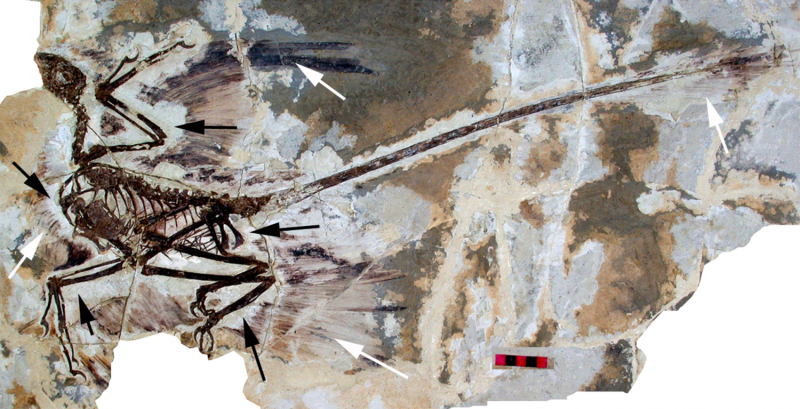Fossil of Microraptor gui includes impressions of feathered wings (see arrows). Credit: PLoS ONE 5(2): e9223. doi:10.1371/journal.pone.0009223
(Phys.org)—Stephen Brusatte, a fellow in Vertebrate Paleontology at the University of Edinburgh in the U.K. has published a Perspective piece in the journal Science outlining the state of current research into the development of flight in dinosaurs. In it, he suggests that contrary to common assumptions, it appears that the path to flight for dinosaurs was anything but a straight line.
As Brusatte notes, when most people think of the evolution of a particular feature or ability, they tend to think of a straight line—a species develops a feature that allows it to do something better; its offspring also express that feature, and soon another feature is added until something like wings for flight develop.
But as he also notes, recent research suggests that is not how flight in dinosaurs came about—instead it appears flight developed in a series of fits and starts, with multiple features evolving that appear related to flight with some that did not actually lead toward flight. He begins by noting that recent excavations have turned up fossils with both soft tissue and feathers—however, he argues that anatomical analysis suggests such a development likely had nothing to do with flying, but instead represented an evolutionary process towards developing insulation to provide warmth or to help with camouflage. Brusatte also points out that some fossils have been found to have wing-like structures that were not meant for flying—they appear to have been used as a form of ornamentation.
To truly understand the evolution of flight in dinosaurs, Brusatte suggests, will require the melding of mathematical models used to measure the likelihood of flight in a given fossil species and biomechanical studies (based on engineering) that take more into account than just feathers—some fossils have been found, for example, that appear to more closely resemble bats than birds, with membranes for wings. The breakthrough, he suggests, will be the development of anatomical models of dinosaurs that truly represent the evolutionary history of early birds., i.e. creatures capable of powered flight.
He concludes by suggesting that as research continues, it appears likely that some of the current evidence attributed to flight evolution will be thrown out even as new evidence of true development is added, eventually giving us a true picture of what transpired.
More information: Stephen L. Brusatte. A Mesozoic aviary, Science (2017). DOI: 10.1126/science.aal2397
Abstract
The evolution of birds from a group of small dinosaurs between 170 million and 150 million years ago has emerged as a textbook example of a major evolutionary transformation in the fossil record (1). The attainment of powered flight—that is, active flapping that generates thrust—has been widely regarded, sometimes explicitly but often implicitly, as a long evolutionary march in which natural selection progressively refined one subgroup of dinosaurs into ever-better aerialists. However, recent fossil discoveries reveal a much more interesting story that is beginning to be corroborated by biomechanical studies. According to this story, the development of flight was chaotic, with different dinosaurs experimenting with different airborne behaviors using different airfoil and feather arrangements (see the figure), until ultimately only modern birds survived.
Journal information: Science
© 2017 Phys.org






















